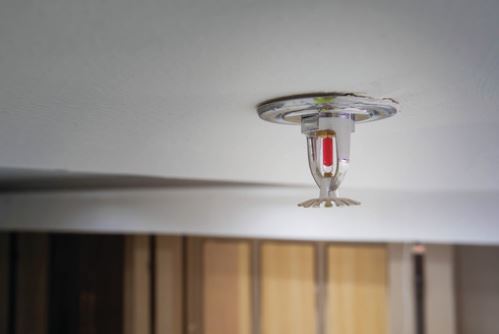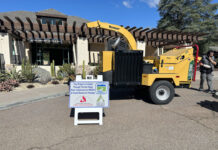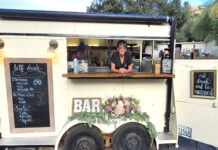Dave Cramer lives in Alpine and decided to invest in new ways to protect his home from wildfires. After investing thousands in fire mitigation for his home, he still pays nearly $6,000 annually between his home insurance without fire damage protection and the CA FAIR Plan.
This is not uncommon for people living in San Diego County, one of the highest risk areas for wildfires. Even with insurance, there is no guarantee it will cover a rebuild if the worst wildfire scenario happens. Cramer recently turned to Frontline Wildfire Defense for help.
Frontline Wildfire Defense provides a purpose-built hardware and software to confront wildfire season, creating homes that defend themselves with wildfire sprinklers and technology that provides real-time wildfire alerts and evacuation coaching, whether you are at home or not.
Frontline Wildfire Defense Founder Harry Statter is a veteran landscape ecologist and fire mitigation expert who has spent his career thinking about how homes can stay protected within the threats of wildfires.
“Our technology will detect and track fire using satellite connectivity to activate exterior sprinkler hardware on homes and businesses to provide firefighter-level protection,” he said. “Ninety percent of structures that ignite during wildfires are from embers that are aloft from 24 miles outside a wildfire perimeter. Those embers will land on the combustible surfaces of the structure. They land on patio furniture, front door mats, adjacent plant fuels. What happens is those embers gather and create a small fire.”
Statter said when talking about 24 miles outside of a wildfire area it encompasses hundreds of thousands of homes, businesses, and industrial properties, and there is no way firefighters can attack all the structures that are exposed at the same time during a wildfire.
“What Frontline has done is we have built a software program that will attack the fire many miles outside of your property boundary,” he said. “We use the software program to activate your sprinkler system that is mounted on your home. Fire embers landing on those combustible items on your structure or plant fuels, the system will saturate all the combustibles on your home up to 30 feet from the walls of your home. When those embers land on those combustible materials there is just too much to burn. Depending on the size of your home, the system will run for 10 minutes, pause for 20 minutes, run for 10, pause for 20…”
Statter said if a fire is burning for two days or for two weeks, you will still have fire protection at your property. That is how the system works.
“We have seen in San Diego County and up and down California, we have had more than 2,500 customer activations when there is fire in California, or fire weather when people are expecting fires but do not know when the fire is going to happen,” he said. “Throughout the U.S., our habitat needs fire to restore itself. It is the most efficient way for those plant communities to regenerate their seedbeds, reduce competition, eliminate invasives. It is a natural part of our plant communities. So, we just need to learn how to live with it. With a Frontline system, that is exactly what we are able to do. Empower homeowners and communities so they are protected from the natural process of fire.”
Statter said with this technology, these mitigations can be utilized even if you are not at home or have already been evacuated. He said the system detects fire within the area, as well as weather criteria, fuel conditions, and it will tell you within 10 minutes at which point you could accept the notification, decline it, or if you are travelling, not at home, or away from your phone, you can just let it run and you will have fire protection.”
Statter said Frontline is a self-defense mechanism and firefighters are focused on life safety, and not there for property protection.
“Private property owners, residential and commercial, need to take matters into their own hands and have a self defense mechanism so they can stay away from fires and keep out of harm’s way and still have their homes and businesses protected by Frontline,” he said.
Statter said the app is a wildfire guide to civilians and customers.
“If you go to the Frontline wildfire tracker you can download the app, see how it prepares messages from the county. Gives information on how to prepare your home, prepare your family in advance of fire. It provides critical wildfire awareness during a fire. If you have a Frontline system, it provides the system activation capabilities. It is a good-looking app. Very functional,” he said. Cramer said he bought his home in 2018 and the first thing he did was to remove shrubbery and trees around the house to be more fire safe. The next year, he installed 113 ember resistant vents that keep embers out of the home, attic, along with larger vents on the roof. He said he saw Frontline online and decided to give them a call.
“It was installed around August 2022 and there are nine sprinklers on the roof. There is a controller system that can be controlled manually at the control center, or I can control it from the app on my cellphone. If cellphone service is down, they can control it by satellite,” he said. “It also has an auto-mode that if we are not responding and the fire gets closer, it can turn itself on. I have not seen that activated. We do test it from time to time, and I generally do that through the app so I can see how it is working,” he said. “It shows fires in the area according to the Integrated Reporting of Wildfire Information [IRWIN]. I do check local fire departments, Cal-Fire, Alpine Fire, because sometimes wildfires reporting on IRWIN have already been closed by the local fire department as they have responded to them and put them out.”
Cramer said the system at the house is normally connected by Wi-Fi, and if it fails it can switch to cellphone service. He said the costs for Frontline for his 3,200 square-foot home plus a three-car garage was around $37,000 installed. He said the original estimate was much higher, but when Frontline came out to his home, they found that they could protect the house with less equipment.
“It can also put foam [firefighting grade] into the sprinklers and would do that at a much later time than when you first turn them on,” he said. “The foam would be used when the fire is much closer and that can be controlled manually, through the app, or by satellite. We are just doing everything we can to make it less destructive to fire. I understand that nothing is 100% guaranteed, but I feel like having this extra system, and using it, gives me some more peace of mind. The fact that I can operate it remotely, because the last two times we have not evacuated for a fire, I still can control the system from wherever I am at. So, that is comforting.”












